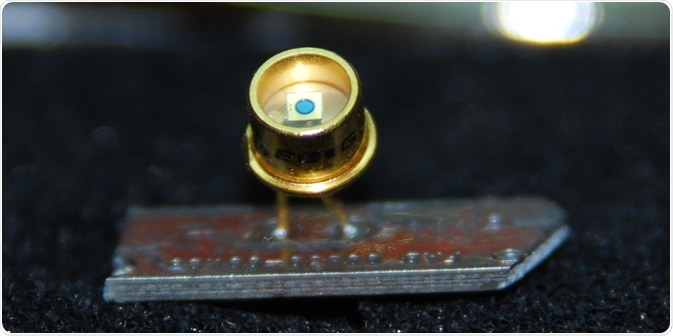Flow cytometers need a mechanism to turn the light of excited fluorophores into an electronic signal. This is done by detectors, of which avalanche photodiodes is an increasingly popular one. The avalanche photodiode is better than the alternative detectors for the detection of emissions with long wavelengths, above 650 nm.

Flow cytometers and detectors
Flow cytometry is a popular method to analyze cells and cell characteristics. For example, one common application of flow cytometry is the detection and analysis of cancer cells. In flow cytometry, cells pass one by one through the cytometer, which allows for individual analysis of a cohort of cells.
Flow cytometry is done with fluorescent labeling or dye methods, where photons are produced when the fluorophore is excited by one or more lasers. Detectors are needed to convert the light produced by the fluorescent dyes into a pulse for the electronic system.
Once in the electronic system, the information is digitized, stored, and can be used for analysis. Avalanche photodiodes are one way of detecting the excited fluorophores.
The commonly used detectors include photodiodes and photomultiplier tubes. Avalanche photodiode is a less common detector, which was typically used in fiber optic telecommunication until it recently experienced a resurgence in flow cytometry. There are also other less common methods, called charged-coupled device camera and the silicon photomultiplier.
How do avalanche photodiodes work?
Photocurrent is another way of describing the electric current that is generated from photons, such as in flow cytometry. The production of photocurrent is required for the analysis and interpretation of flow cytometry results, but the method in which this is achieved can vary.
In many ways, avalanche photodiodes work like a regular photodiode. When a photon is triggered and hits the photodiode, the detector’s atoms ionize into an electron and a hole inside the photodiode. This occurs in what’s called the depletion region of the photodiode.
Unlike regular photodiodes, avalanche photodiodes have an intrinsic gain due to their silicon atoms. In the depletion region, there is an impact ionization of silicon atoms, creating new charge carriers. This is achieved thanks to reverse-biased to a voltage slightly less than the breakdown voltage (at around 150 to 400 V).
The voltage of the reverse-bias means that avalanche photodiodes typically operate in linear mode but biasing the photodiode above breakdown voltage can allow it to function in Geiger mode.
Once in the depletion region, the electrons are moved towards the positive potential on the cathode and the holes are moved towards the negative potential on the anode. This creates a photocurrent that is moved to the electronics system of the flow cytometer.
How do avalanche photodiodes compare to other detectors?
The impact ionization in avalanche photodiodes allows for a gain (number of electrons) of around 100. While this allows for the detection of different light wavelengths to a spectral range of 400-1100 nm (especially above 650 nm), it also increases the noise.
Avalanche photodiodes have typical excess noise values of around 3.5, which is high compared to other methods. For example, silicon photomultiplier tubes have excess noise of around 1.1-1.2.
Compared to photomultiplier tubes, avalanche photodiodes have a lower internal gain (however, compared to the silicon photomultiplier the gain is similar). While this disadvantage may have stopped avalanche photodiodes from gaining popularity until recently, this can be fixed by adding an external amplifier. This allows the avalanche photodiodes to operate at the best number of electrons. Current tests show that external amplifier can allow for gain values of 200 to 500, while not amplifying the signal to noise ratio.
Quantum efficiency is the measure of how many photons were collected at the photoreactive end compared to the number of charge carriers collected at the terminal end. Avalanche photodiodes have higher quantum efficiency than other detectors such as photomultiplier tubes, which makes them an attractive alternative.
The higher quantum efficiency of avalanche photodiodes leads to consistently lower variation coefficients in the data collected and makes it more reliable.
However, many avalanche photodiodes have smaller active areas, which means the collection optics need to be carefully aligned to avoid loss of signal. Furthermore, the sensitivity of avalanche photodiodes differs across the active area, being more sensitive at the center.
Sources
- Piatek, S., and Hergert, E., 2018. Photodetectors In Flow Cytometers. [online] Photonics.com. Available at: <https://www.photonics.com/Articles/Photodetectors_in_Flow_Cytometers/a64058>
- Thermofisher.com. 2020. Optics Of A Flow Cytometer. [online] Available at: <https://www.thermofisher.com/au/en/home/life-science/cell-analysis/cell-analysis-learning-center/molecular-probes-school-of-fluorescence/flow-cytometry-basics/flow-cytometry-fundamentals/optics-flow-cytometer.html>
- Lawrence, W., Varadi, G., Entine, G., Podniesinski, E., and Wallace, P., 2008. Enhanced red and near-infrared detection in flow cytometry using avalanche photodiodes. Cytometry Part A, 73A(8), pp.767-776.
- Lawrence, W., Varadi, G., Entine, G., Podniesinski, E., and Wallace, P., 2008. A Comparison of Avalanche Photodiode and Photomultiplier Tube Detectors for Flow Cytometry. In: The International Society for Optical Engineering. The International Society for Optical Engineering.
Further Reading
Last Updated: Aug 3, 2020